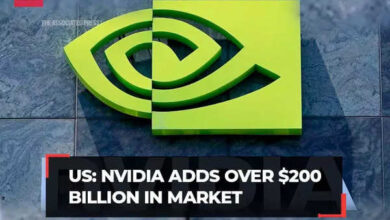Why Nvidia, Arm Holdings, and Other Artificial Intelligence (AI) Stocks Rallied Wednesday Morning

Incremental improvements in the state of the economy ignited a broad-based market rally.
One of the biggest catalysts propelling the market rally since early last year is the proliferation of artificial intelligence (AI). On the other hand, the uncertain state of the economy and stubborn inflation have acted as counterweights, helping to limit investor exuberance.
The Federal Reserve Bank has remained steadfast in its resolve, refusing to lower interest rates until inflation is under control. As a result, interest rates remain at a 20-year high, and investors are keen to see them come down. The latest read on inflation was better than expected, sparking a broad-based market rally.
With that as a backdrop, chip designer Arm Holdings (ARM 6.78%) rose 4.1%, chipmaker Nvidia (NVDA 4.31%) jumped 3.9%, memory and storage chipmaker Micron Technology (MU 3.81%) climbed 3.4%, AI solutions provider C3.ai (AI 1.47%) increased 1.9%, and semiconductor giant Broadcom (AVGO 1.85%) rallied 1.3%, as of 11:59 a.m. ET on Wednesday.
A check of all the usual sources — regulatory filings, earnings results, and changes to analysts’ ratings and price targets — turned up a few nuggets of company-specific news that helped drive these AI stocks higher (more on that in a moment). That said, most investors are pleased with the incremental economic improvements and what they mean for the future.
Image source: Getty Images.
Persistent and stubborn inflation
The latest monthly report on inflation, handed down by the U.S. Bureau of Labor Statistics, showed that prices continued to cool, a welcome development for cash-strapped consumers. The Consumer Price Index (CPI), the most widely followed gauge of inflation, rose 3.3% in May compared to the year-ago period. Prices were flat month over month. This marked the first time in nearly two years that the CPI didn’t increase sequentially.
Both numbers came in better than expectations, as economists had predicted inflation would increase 3.4% year over year and 0.1% sequentially. The “core” data, which excludes volatile food and energy prices, was up 3.4% compared to this time last year and climbing 0.2% sequentially, both lower than expectations of 3.4% and 0.3%, respectively.
The Fed continues to target its elusive 2% inflation goal, but Wall Street was eager for any signs of improvement, sending investors on a buying spree.
The underlying data shows the battle is far from over. While grocery prices were flat, gas prices rose 2.2%, and shelter prices — primarily made up of rental rates — posted a fourth sequential month of increases, as consumers are plagued by stubbornly high housing-related costs.
Investors have been eager for the Fed to begin reducing interest rates, which would boost economic activity. However, the central bank had signaled it wouldn’t go down that path until inflation began to cool. This marks the first positive sign in some time, though the Fed will likely require additional evidence before it begins to cut rates.
Other catalysts
There were other developments in the space that helped fuel the AI rally.
In the wake of its high-profile 10-for-1 stock split, Nvidia was on the receiving end of bullish sentiment from Wall Street. Analysts at Oppenheimer and Argus both maintained the equivalent of buy ratings on the shares while raising their respective price targets on Nvidia stock to $150.
This represents potential gains of 24% for investors compared to Tuesday’s closing price. Oppenheimer sees Nvidia as “best positioned in AI” thanks to its full stack of networking, hardware, and software, while Argus believes Nvidia shares “have much further to go” and is positioned for “continued momentum” in fiscal 2025.
Broadcom was also singled out with some bullish commentary courtesy of analysts at Citi, who suggested the company will report a “beat and raise” quarter, driven by robust AI sales and the continued integration of its acquisition of VMware.
While AI has taken center stage since early last year, some businesses have been reticent to increase spending on new technology, particularly if it involves taking on additional debt at higher interest rates. The promise of increased productivity offered by generative AI hasn’t been enough to cause most companies to make the required initial investment until the economy is on more solid footing.
Investor excitement has driven valuations higher in the space. For example, Micron Technology, Arm Holdings, Nvidia, and Broadcom are selling for 174 times, 96 times, 46 times, and 31 times forward earnings, respectively — and C3.ai isn’t even profitable.
Nvidia has already demonstrated its ability to profit from the AI revolution, with four successive quarters of triple-digit growth and a forecast of another one on the way. So, it has earned a premium valuation and is my favorite of the group. Arm Holding has generated three consecutive record-setting quarters, boosted by its gatekeeper position in the AI ecosystem. Micron and Broadcom are more expensive but are also well positioned to benefit from the surge in AI use. With an uncertain strategy and lack of profits, I view C3.ai as simply too risky, but time will tell.



